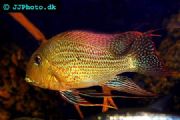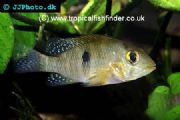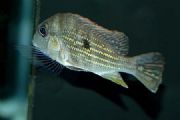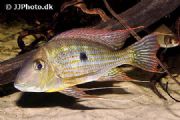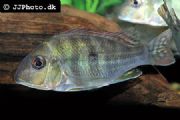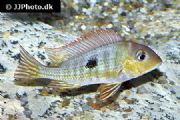Article categories:
Select a category below to view articles on each subject.
Search
Enter your keyword/s below to search :

Fish delivered straight to your door from Wildwoods
Hundreds of Species available today…
TFF Mailing List
Join the TFF mailing list today and we will email you with latest offers, news items and more.
Geophagus
The Eartheaters are a group of fish known for their feeding behaviour by which they sift the substrate of their environment for food. One genus of the group, Geophagus, is popular in the aquatic trade due to its members’ usually more peaceful nature as opposed to other cichlids as well as their striking colours. A group of Geophagus can make for an impressive display.
Taxonomy and Distribution
The Eartheaters are a group of Cichlid species endemic to waters throughout South America. The group is consisted of five genera including Biotodoma, Gymnogeophagus, Retroculus, Satanoperca and Geophagus. The Geophagus species is widespread throughout four major river basins throughout South America and can be found as far south as Uruguay. There are around 25 species in the genus but it is thought that Geophagus is in need of more taxonomic revision.
General Care
Geophagus species are capable of reaching lengths in excess of 25cm and as such a larger aquarium is required to house members of this genus. Provide a tank that is at least 180cm long for a group. These fish are highly sensitive to metabolites in the water such as nitrate and hence high standards of water quality management are usually required. Provide excellent filtration along with weekly 50% water changes. Also, it is recommended that RO water as opposed to tap water be used as tap water usually contains high levels of nitrate. The substrate should be soft and sandy as Geophagus species are benthophagous; in order to feed they take mouthfuls of substrate and sift it for food and expel any remaining matter via their operculum. If too large or rough a substrate is used serious damage on the gills could occur. In the wild these fish inhabit soft, acidic waters and as such they should be provided with these conditions in captivity, especially if they are wild-caught specimens. Geophagus species will have difficulty ingesting larger items of food and as such should be provided with a diet of live or frozen smaller foods such as tubifex, artemia or blood worm. Dried products containing high levels of vegetable matter such as spirulina should also be offered.
Geophagus altifrons
Geophagus altifrons is one of the more popular species seen in the industry. Endemic to the Amazon River (but is also now established in Asia) it is an attractive species with vivid colouration that is capable of reaching 25cm in length. This species, unlike most Cichlids, is relatively peaceful (except when spawning); it will not usually predate on fish a few millimetres small or bigger and will do well when kept with most other peaceful species requiring the same conditions. This species is gregarious and as such should be kept in groups of no less than five. It can, however, be aggressive towards other cichlids. Avoid keeping with bottom dwelling or aggressive species.
Pearl Cichlid Geophagus brasilienis
The Pearl Cichlid Geophagus brasilienis is a striking species originating from the eastern and southern river systems of Brazil and Uruguay. It is typically greenish in colour with iridescent spots along its body and it is capable of reaching 28cm in length, although it is usually smaller with males being larger than females. It is relatively peaceful, but will usually predate on smaller fish and it is territorial to its own kind. This species typically displays less of the genus’ characteristic benthophagous behaviour and can be fed on a staple of sinking pellets coupled with live or frozen feeds of items such as bloodworm or artemia.
Geophagus neambi
Although having only been described in 2010, Geophagus neambi has been available for several years before then often being sold as several other species of Geophagus. It is a stunning species originating from Brazil capable of reaching up to 20cm in length. Like G. altifrons, it is very peaceful, being compatible with most other peaceful species tolerant of the same water quality and it will not consume fish a few millimetres in length and bigger. Avoid keeping it with benthic species. As with most Geophagus species, feed on smaller foods such as tubifex or artemia.
Yellowhump Eartheater Geophagus pellegrini
The Yellowhump Eartheater Geophagus pellegrini is an attractive, rarely seen species originating from north-western Columbia with males being yellow in body colour with dark vertical marking along the side of the body while females tend to be a little drabber. It is smaller than many species of the genus, reaching an adult length of just 15cm. The tank should be dimly lit. This is a peaceful species that will not consume fish larger than a few millimetres in length and will do well with other peaceful fish tolerant of the same conditions.
Geophagus taeniopareius
Geophagus taeniopareius, native to the Venezuelan portion of the Rio Orinoco in South-America, is one of the more scarcely seen species of Geophagus in the aquatic industry. Reaching around 15cm in length it is dull yellow in colour with fins flecked with light blue. It has a dark spot in the middle of its body and a brownish bar running vertically across the eye. This species is one of the more aggressive species of Geophagus available, but it can and indeed should be kept in groups no smaller than five in a larger aquarium. It can also be housed quite happily with groups of smaller fish such as characins without predating on them.
Other fish articles:
Other fish articles you may be interested in are listed below, click an article for full details.
-
FISH ARTICLE
-
FISH ARTICLE
-
FISH ARTICLE
-
FISH ARTICLE






